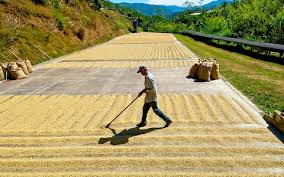
THE DRY-PROCESS METHOD
As the seed of a coffee cherry, the coffee bean is removed from its fruit by one of two processing methods. The dry-process (also known as the natural method) is the oldest approach and produces coffee that is sweet, smooth, complex, and heavy-bodied. In the dry-process method, coffee cherries are sun-dried in thin layers on brick or cement patios or in raised drying beds. The fruit is raked or turned by hand at regular intervals to ensure that the cherries are uniformly dried. Depending on the weather conditions, it may require up to four weeks before the cherries are dried to their optimum moisture content. The fruit is then removed by machine to isolate the coffee beans. Sugars from the drying cherry imbue the coffee bean with sweetness and impart more soluble solids to the bean that amplify its body.  This dry-processed method is often used in countries where rainfall is scarce and long periods of sunshine are available to dry the coffee properly. Coffees from Sulawesi, Brazil, Sumatra, and Yemen are dry-processed, as well as some from Ethiopia, Mexico, and Nicaragua.
This dry-processed method is often used in countries where rainfall is scarce and long periods of sunshine are available to dry the coffee properly. Coffees from Sulawesi, Brazil, Sumatra, and Yemen are dry-processed, as well as some from Ethiopia, Mexico, and Nicaragua.
THE WET-PROCESS METHOD
The wet-process method (also known as the washed method) results in coffee with a cleaner, brighter, and fruitier taste profile. Most countries whose coffees are prized for their high-grown flavor and acidity generally rely on the wet-process method to showcase their coffee. In the wet process, the coffee bean is defruited before it is dried. The skin of the cherry and some of its pulp is removed by pressing the fruit through a screen immersed in water. Since a significant amount of the pulp will still cling to the bean, another procedure is applied to remove all fruit. Coffee beans are sun-dried on a cement patio. The coffee beans are then ready to be sun-dried on patios or on waist-high drying tables, typically followed by machine drying to bring down moisture content to 10%. Coffees from Colombia, Costa Rica, Guatemala, Kenya, Java, and Papua New Guinea are wet-processed.
The drying procedure is the most important stage of the process, since it affects the final quality of green coffee. A coffee that has been overdried will become brittle and produce too many broken beans during hulling. Broken beans are deemed defective beans. On the other hand, coffee that has not been dried sufficiently will be too moist and fall victim to rapid deterioration via fungi and bacteria.
For coffee producers, selecting a processing method is a decision borne out of necessity, tradition, and/or the intent to achieve a specific flavor profile. In Guatemala, for example, dry processing is a poor fit for the coffee grown there. Owing to the country’s high humidity, a dry processed coffee would likely become fermented. Conversely, Brazilian coffee growers rely on the dry-process method to achieve the sweet, heavy-bodied taste qualities that are the hallmark of Brazilian coffee.
